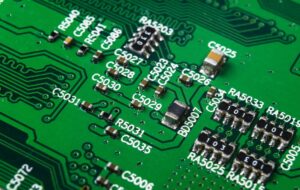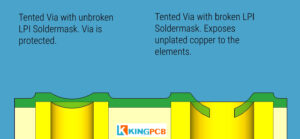Why Via Tenting is Important in PCB Manufacturing?
2022-11-11
If you have ordered and used PCBs, you have probably heard of the use of vias in printed circuit boards. Vias play an important role in the connections between the layers of the board, and they serve two main purposes.
- Electrical signal conduction
- Heat dissipation
In many cases, the through-hole is copper-plated. Some PCB manufacturers believe that these holes should not be exposed, when the vias are completely covered, called filled vias. There is another popular method of tenting vias.
What is PCB Via Tenting?
As the name implies, tenting vias means creating a tent-like shape on the vias. Tenting a vias means covering the toroid and vias with a solder resist layer, primarily covering the toroid to prevent exposure to components and reduce accidental shorts or contact with the circuit. Whether to use tenting in PCB manufacturing depends on the design of the board.
Why is PCB Via Tenting important in PCB manufacturing?
There are several ways to protect printed circuit boards from vias. For cost reasons, tented vias are usually preferable to epoxy filling. Most forms of tenting are LPI (liquid imagerable solder resist). PCB solder resist protects copper traces from oxidation, damage and solder bridging, which also applies to over-hole protection.
If your PCB is designed with a through-hole assembly, the tent through-hole will prevent solder from flowing up into the through-hole and over the other side of the PCB when using wave soldering.
The vias near the SMT pad should also be tented. This will prevent the solder paste wick from sucking into the via hole and creating a bad solder joint.
Disadvantages of PCB Via Tenting
Since the LPI solder resist is a liquid, it must “bridge” the gap above the via. This results in the solder resist not completely covering the via, leaving a small hole.
These small holes can be used for corrosive fluxes, moisture and other chemicals to enter the vias. This can lead to failure due to corrosive vias.
This is not an issue due to the popularity of no-clean flux in SMT assembly, but corrosive water-clean flux is still prevalent in through-hole assembly.

Under what circumstances is PCB Via Tenting used?
Whether to use Tenting depends firstly on the PCB design, and secondly on the size of the via.
Tenting vias are suitable for through-hole diameters of 12 mil or smaller. If you are dealing with larger vias, using filled vias is a better option, it is relatively more costly.
Contact KingPCB for PCBs with tented or non-tented vias
At KingPCB, we have experience with almost all types of printed circuit boards. We can help you find boards in a variety of materials, in flexible or rigid-flexible formulations, with tented vias, filled vias, blocked vias, open vias, or a combination of these.
Our high quality manufacturing, ability to deliver, and quick response sets us apart!
Contact us now to get more information about our PCB manufacturing capabilities!



